
Serengeti's Great Migration: the world's ultimate wildlife spectacle
Nov 1, 2021 • 14 min read

Serengeti National Park, Tanzania. PHOTOSTOCK-ISRAEL / SCIENCE PHOTO LIBRARY / Getty Images
Often billed as the world’s ultimate wildlife spectacle, the Great Migration of wildebeest and zebra takes place annually across the plains of East Africa; Amanda Canning travels to Tanzania to try to catch up with the herds.

First day on safari: slow gnus day
It’s been an excellent night for the predators of the Serengeti. As the sun starts to inch over the horizon and casts a pale light over the acacia-pocked plains, it reveals a scene of nocturnal carnage. There are bones here, bones over there, bones everywhere. White bones picked clean and dazzling as if fashioned from porcelain; scrappy, dirty bones, bits of unidentifiable flesh still clinging to them; bones that retain the shape of the animal from whence they came.
Above it all, vultures wheel through the sky or sit hunched in acacias, occasionally floating down to earth to better inspect a kill, looking every bit as sinister as one might hope from their villainous, cartoon reputation. A good number of the night’s revelers are still out, enjoying the last bits of the feast before heading home for a day’s solid napping.

We’ve not long left our camp on the Namiri Plains before my guide Noel Akyoo spots a flurry of activity in the distance and bumps the Land Cruiser in its direction. A hyena trots past, the back legs of a Thomson’s gazelle dangling from its jaws. Beyond him, a group of around 20 hyenas is gathered around the rapidly disintegrating carcass of a wildebeest, some plastered in blood up to their shoulders. They break into a fight, squabbling over a prime piece of meat, before continuing to feed in a riot of chattering and whooping. A pair of jackals sits nearby in eager anticipation, not brave enough to move in, too hungry to move on. In a tree behind them, a tawny eagle pulls at a rib held in its yellow talons.
The Serengeti’s predators don’t always have it this good. I’ve timed my visit to coincide with the Great Migration, the annual 1,200-mile journey of 1.5 million wildebeest and 250,000 zebra between Tanzania and Kenya, following the rains and the grasses that spring up in their wake. The season is bonanza time for any creature that counts them as dinner – for the lions, cheetahs, leopards, hyenas and wild dogs here, hunting at this time of year requires as much effort as picking a dish from the conveyor belt at Yo! Sushi. It must be, I assume, fairly easy for a human to track down the migrants too.
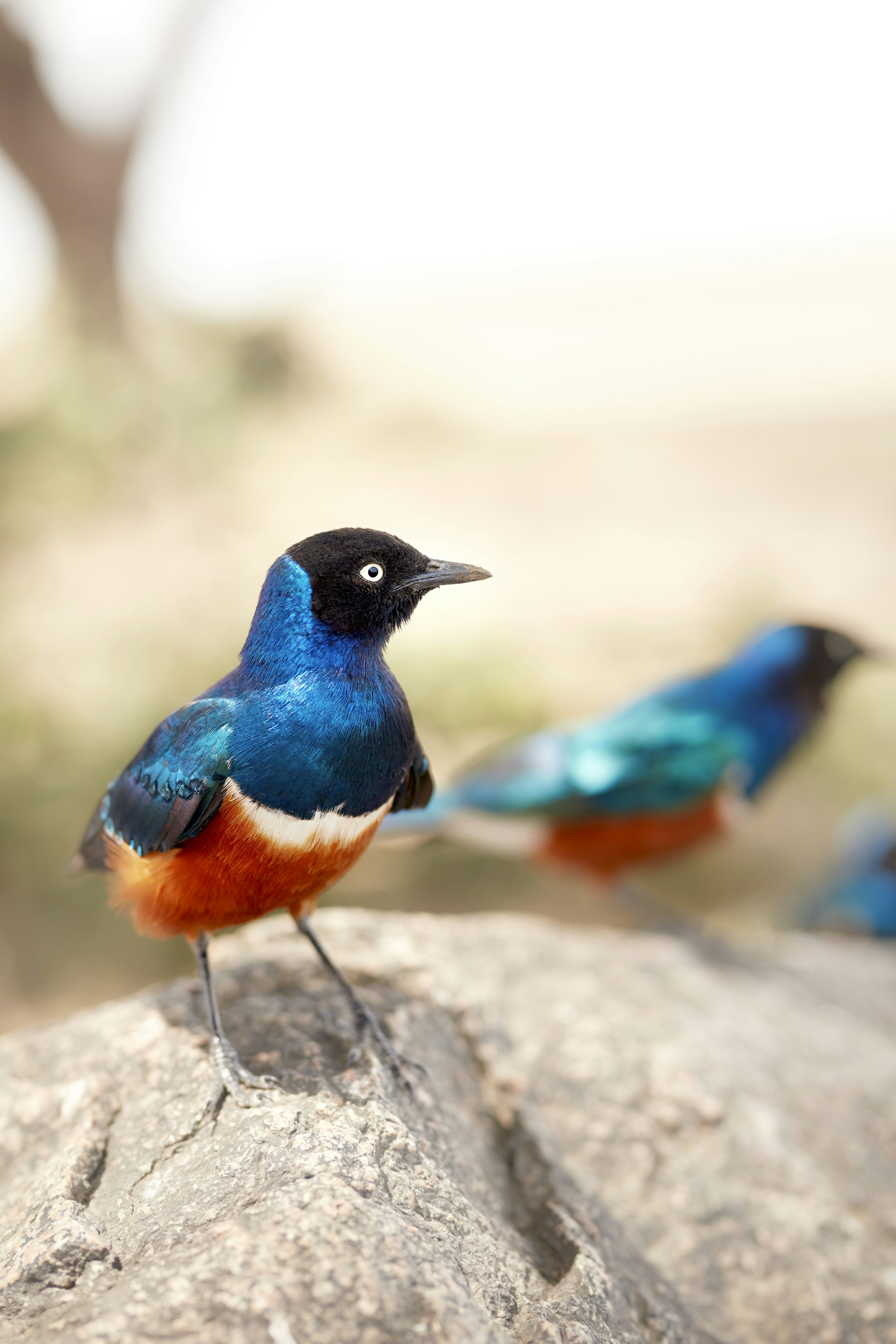
I am wrong. There is plenty of evidence of deceased wildebeest, and small living clumps of them idling about or plodding to some unseen destination across the plains, but I expected to be overwhelmed by thousands upon thousands of the beasts, thundering past in clouds of dust.
Where you should go on your first safari in Africa
Noel moves the Land Cruiser off and we trundle along rutted tracks. "We will try and find them," he says, "but the migration was early this year. The herds are already moving south to give birth in the woodlands." He laughs. "That is the beauty of the Serengeti – you never know what you’re going to come across." What we do come across on that first day is extraordinary enough. There are the wonders of animals not generally on people’s wildlife checklists: the bright flashes of superb starlings come to investigate what we are; a long-horned beetle slowly eating a yellow fever tree from the inside out; the pointy ears of a caracal hiding (badly) in the long grass. And there are the big-hitters too.

The Namiri Plains is known for its cheetahs, at one point off-limits to visitors for over 20 years in an effort to increase their numbers. We spot several through the day, their long, thin bodies stretched out in the dust or pulled upright on termite mounds, alert to the hint of prey. There is an embarrassment of lions too, lolling about in the grass or cooling themselves on the rocks, tiny cubs tumbling about like furry drunks as the pride males consolidate their standing as the rock stars of the savannah, manes billowing in the wind and backlit by the setting sun.
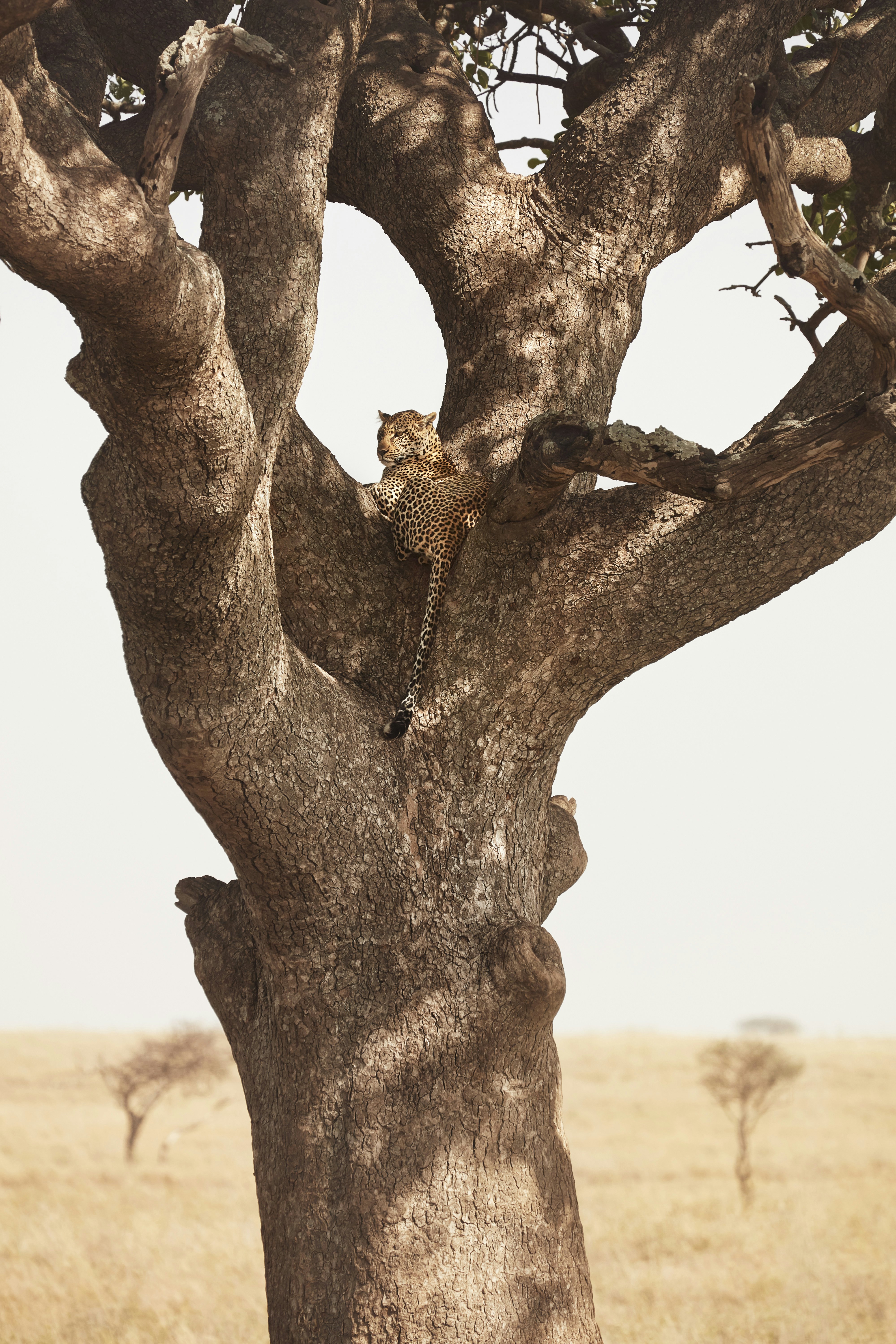
We have the rare privilege of spotting a leopard, too, an elegant female tucked into the crook of a tree, her long tail twitching against the trunk. Returning to camp, though, I can’t help but be nagged by the somewhat ungrateful thought that the trip represents the only chance in my lifetime to experience one of the world’s greatest wildlife spectacles, and it’s happening somewhere else. Noel is unconcerned. "Every day is different," he says, clambering out of the vehicle. "There is always tomorrow."

Second day on safari: hot-air balloon over the Serengeti
The day starts beneath a billion stars. I am standing outside my tent, watching as two shoot across the inky sky when the deep guttural rumble of a lion reverberates through the darkness. It is likely some way off, down by the river bordering the camp, but it is a sound of such primordial resonance, my entire body seems to vibrate to it.
With dawn approaching, the lion’s time to hunt is over: it’s my turn to take on a shift. The day has brought a change in tack: if we can’t find the migration from the ground, perhaps we’ll have better luck from the sky.
The story of lions (and your guide on where to see them on safari)
The last stars are fading as our hot-air balloon slides into the sky. For the first few minutes, we skim across the ground, past trotting warthogs and strutting ostrich, then suddenly we are a hundred meters up, with all of the Serengeti stretched out beneath us. It is a vast beige sea, dotted with acacias and granite outcrops. The Seronera River wiggles through it, the shiny lumps of a hippo pod visible in its shallows.

Pulling on the burner, captain Mohamed Masud studies the ground beneath us. "You can see how busy this area gets in migration time," he says. "There are so many trails." The earth looks scratched, there are countless pale lines cut into it, rift into the ground by millions of hooves passing this way for a million years. There is little sign of the herds this morning though. "We don’t really know where they are now," continues Mohamed. "The rain has not come so the migration is really spread out. Maybe if it rains, it will come."
A day on safari in Africa: what you can expect in camp and in the wild
The grazing animals that live in this patch of the Serengeti year-round are out in force. Giraffes bob across the savannah, galloping for cover on gangly legs as we sail overhead, their unexpected arrival into woodland marked by the alarmed calls of ibis and morning doves. As I peer after them, I spy several groups of animals standing unmoving among the trees: wildebeest. Not thousands, not thundering past in clouds of dust – but wildebeest all the same.
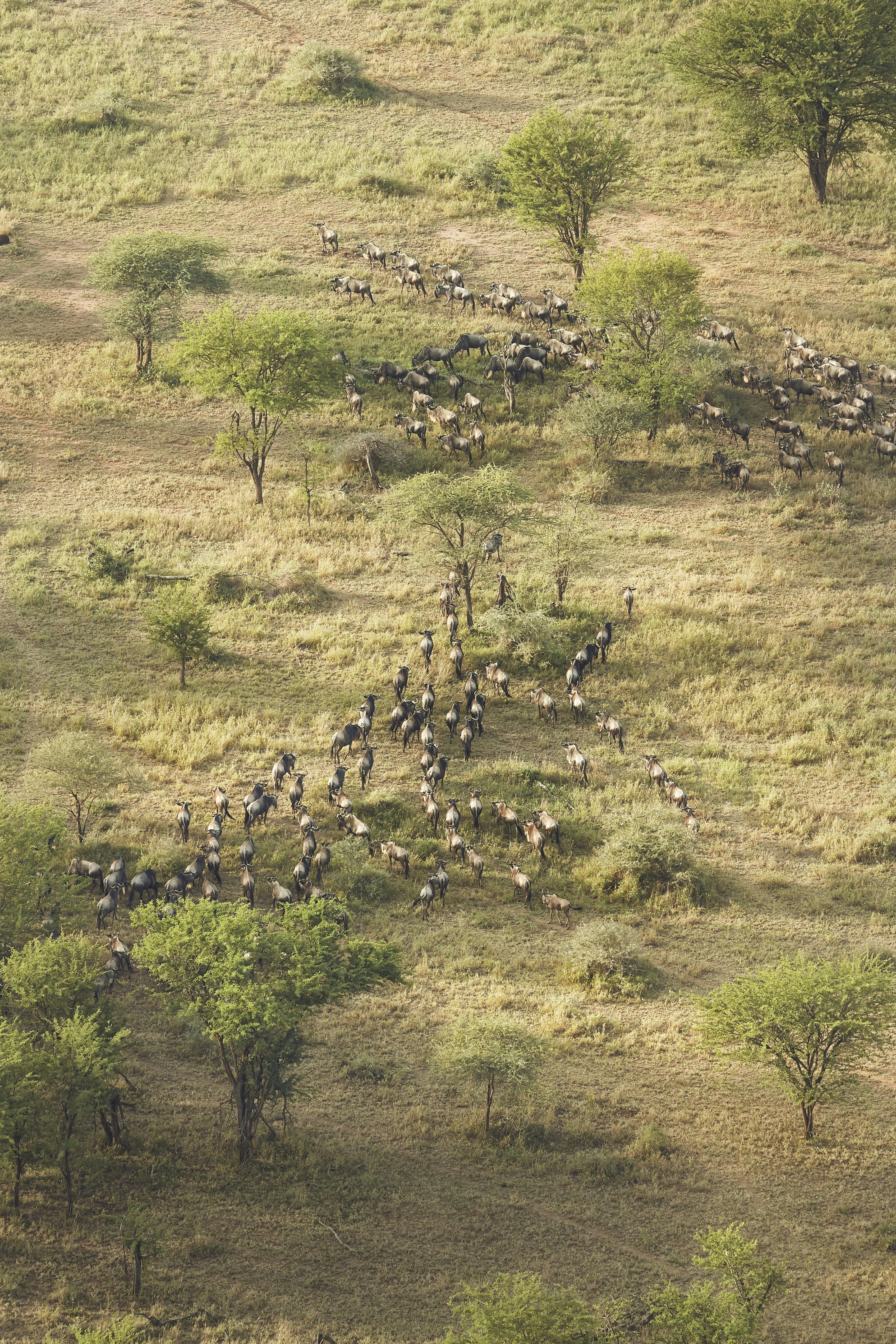
Back on the ground, we head towards the woods and almost immediately catch up with our target. A long line of several hundred wildebeest is plodding towards the river. They need to cross a road to join the huddles I’d seen from the balloon, but none seems willing to make the first move. "The thing about wildebeest," says Noel, "is that they don’t have a leader. If the one in front changes direction, they all follow." We watch as they make slow comedic progress towards their goal. One animal bolts, and a hundred animals bolt. One stops, and they all stop. One starts heading back the way it came, and within minutes, the entire herd has spun around. It takes a good two hours of confused milling before they finally muster up the courage to cross.
As we lurch back to camp, triumphant after the first, small taste of the migration, I turn and take a last look at the herd: behind them, fat, dark clouds are starting to bubble on the horizon. The rains are coming.
Third day on safari: cheetahs hunting on the Serengeti plains
If the migration is heading south, then so must we. It’s a short bounce in a light aircraft to the next camp in the southern Serengeti. From the air, it’s clear we’re catching up with the wildebeest: far below, innumerable black dots are moving steadily in the same direction as we are.
From the airstrip, my guide Charles Joseph takes us straight off to a herd he’s been following for a few days. Many thousand wildebeest, the odd zebra mingled among them, are plowing across the plains, a huge billowing cloud of dust rising overhead. The line is so long we can’t see the front or end of it. "This group has been moving back and forth for nearly a week," says Charles. "They’re looking for water."
We are not the only ones watching. All around them, predators lurk, waiting for night. There is one creature that needs not the cover of darkness to mount an attack. Across the plains, Charles spies a cheetah and her cub sheltering behind a whistling thorn acacia. The mother is restless and apparently hungry. "Cheetahs are right down the pecking order of predators," says Charles, as large globs of rain start to splatter into the dust around us. "They can’t compete with a lion or a wild dog, so their only advantage is to hunt in daytime."
We spend the next few hours tracking the mother as she locks sight on her prey, readies to attack, and is then spotted and her plan thwarted. Soon the savannah is a vast soggy field, and the cheetah is perfectly camouflaged within it. Still, every gazelle seems wise to her approach. She has traveled several miles before she gets her chance. Hunkering down in long grass, she waits for two gazelles to approach. They walk past her, oblivious, and she does not move. Just as I imagine she’s missed her chance, she is off and after them in an explosion of force. Within 20 seconds, one gazelle is down. The mother and cub take it in turns to feed, one constantly watching out for scavengers. "You can’t relax for a second out here," says Charles as three vultures land nearby. "The hyenas won’t be long. They’ll have seen the vultures circling and will follow."
Their luck holds, however; the only creatures that come to join the party are dung beetles, which whirr in from all directions and have a marvelous time in the gazelle’s bowel. The cheetahs leave only the head and bladder intact. "The hyenas will have that," says Charles. "They don’t really care what they eat." I’ve been so transfixed that it’s only when the pair drop full-bellied into the grass that I become aware of the life now brimming on the plains: there are thousands upon thousands of wildebeest, behind, in front, to the side, trudging ever on.
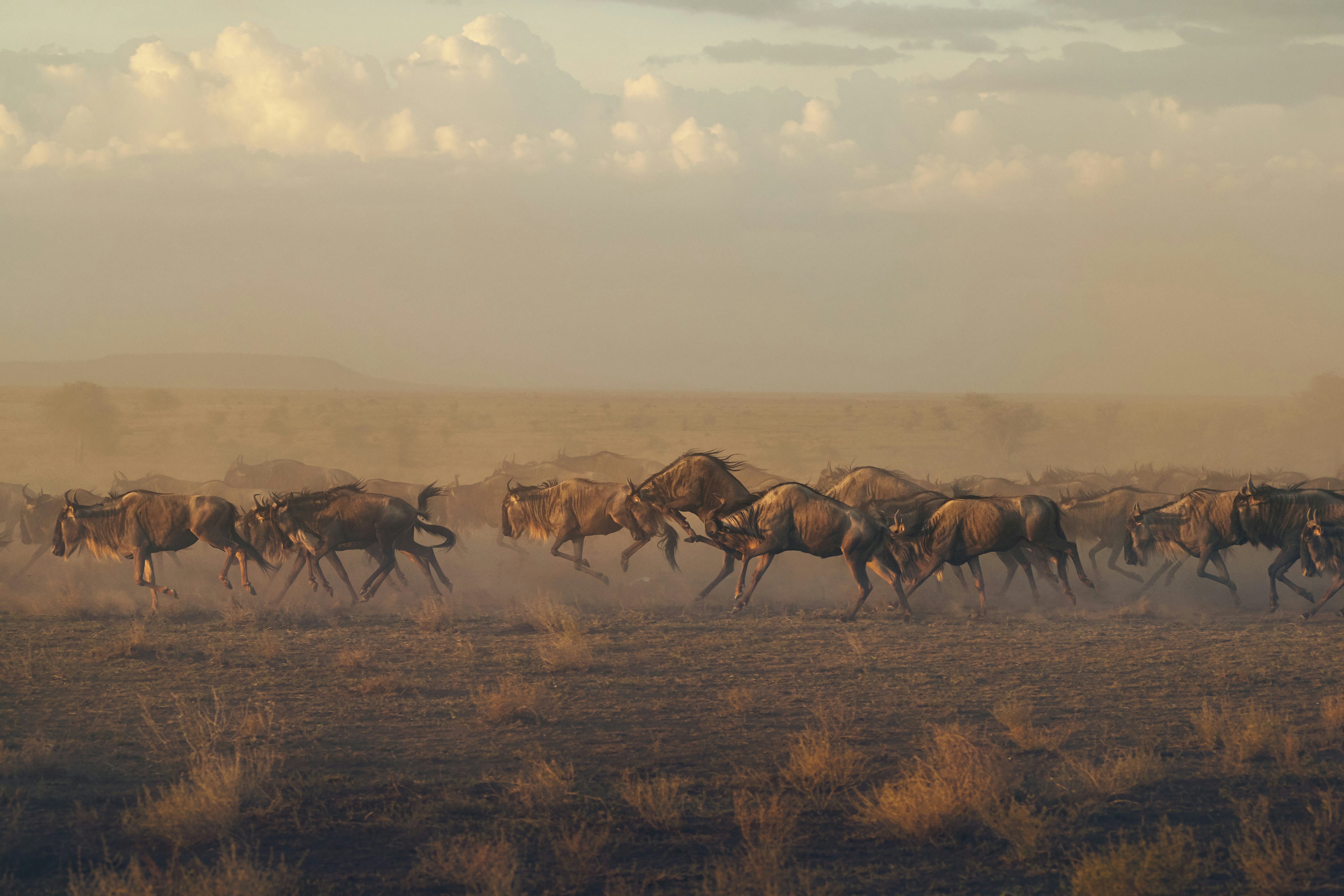
Fourth day on safari: wild dogs and death on the Great Migration
Overnight, our camp has become a motorway for the migration. I could spend the day in bed and watch it pass meters away, but we decide to head further south, where they’ve had more rain, to try to catch the rest of the herds.
We drive for a few hours, crest the Maru Hills – and there before us is the Promised Land for grazing creatures. There is not an inch of the earth not occupied by one. Gnus and zebra stand grunting, resting in the shade of trees or splashing about in rivers. Baboons sit and pick at each other’s fur. Elephants roam, hosing their hides with water from their trunks. The grass is green and long, the fruit on the trees plentiful and ripe. If I were a wildebeest, I’d walk a thousand miles for this too.
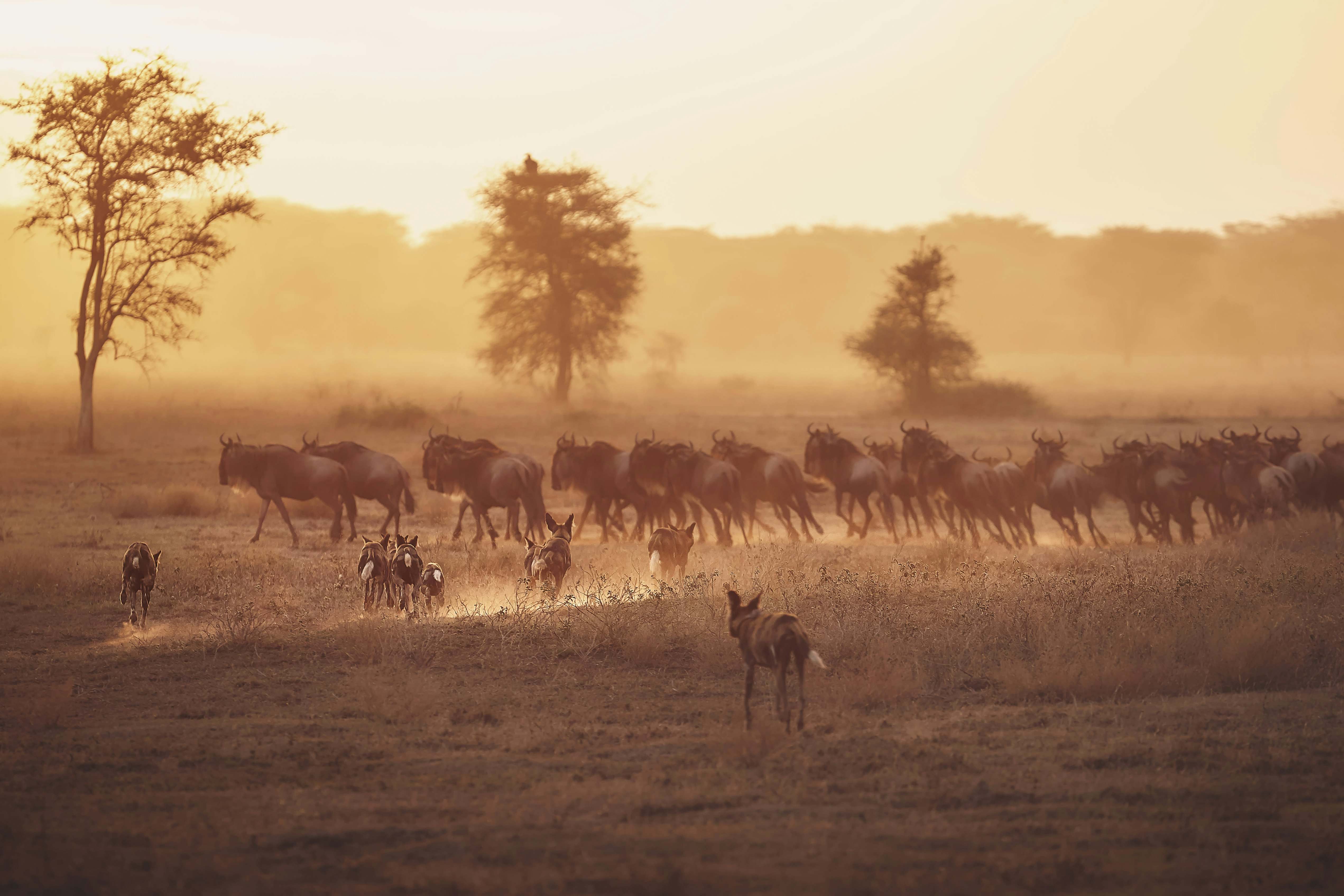
Returning home in the warm glow of the setting sun and the satisfaction of a mission accomplished, we’re drawn to a commotion close to camp. Thousands of wildebeest are stampeding, and we soon see why: wild dogs. A pack is herding the animals into groups, assessing which to target. It’s a world of confusion: dust flying, legs kicking, prey grunting, predators barking, and the rumble of hooves like a drum beat to it all.
And then the Serengeti pulls off the world’s greatest magic trick and makes the entire scene disappear. We sit in silence in the murk, the dust slowly settling around us. A bark comes in from the left, and off we go. When we rejoin the hunt, it’s apparent the pack has marked its prey: a juvenile is being forced out of the herd. "They’re super hunters, one of the best predators in the world," says Charles. "Once they have made a decision to hunt, they do not stop until they have their kill."
The wildebeest is done for. A dog gets hold of its leg and pulls it down. The pack is upon it in a frenzy, wary that a lion might turn up and make off with the spoils. It takes an excruciatingly long time for the animal to die. It’s still alive and trying to get up as one dog runs off with its liver and another its intestines.
I return, queasily, to camp to find the wildebeest and zebra still passing through. It is a steadying sight, the timelessness of the endeavor brought into sharper focus after the macabre events of the last hour. Naturally, the animals are marching solemnly in the opposite direction they had been that morning. They may know where they’re going, but they’re not going to get there any time soon.

When to go on Great Migration safari in the Serengeti
The animals follow the same path each year, traipsing back and forth between the Serengeti in Tanzania and the Masai Mara in Kenya. The migration does not follow a strict schedule, however, and its precise location in any one month cannot be guaranteed. Factors such as an early or late rainy season will affect when the 1.5 million wildebeest and 250,000 zebra start to move. If you’re booking well ahead, it’s wise to go with a tour operator or camp who is able to change your itinerary depending on the herds’ progress. The below is a rough guide only.
January to March: Grazing and calving in the southern Serengeti
April to May: Herds start to move north, passing through the central Serengeti
June to August: Cross the crocodile- and hippo-infested Mara River and head into the Masai Mara
September to October: Grazing in the Masai Mara
November to December: Return south, and the cycle begins again
Need to know
Check ahead with the US Embassy in Tanzania for the latest updates regarding COVID-19 testing and vaccine requirements.
You’ll need an up-to-date yellow fever vaccination to enter Tanzania. Don’t forget to bring your certificate – you’ll need to show it at the airport on arrival.
You’ll want a course of anti-malarial drugs to cover your stay, and to bring mosquito repellent. If you don’t like DEET-based or other chemical repellents, we’ve found the natural, citronella versions effective (and considerably less stinky).
The plains can be dusty, particularly on windy days. Bring a light scarf or Buff to cover your face. You’ll want a jumper or jacket for cooler morning game drives.
Your guide will have a pair of binoculars they’ll likely let you borrow, but it’s worth bringing your own. A pair with 8x or 10x magnification will do the trick.
Don’t bring bright or patterned clothing that will make you stand out to all animals within a mile radius; plain grey, green or beige clothes are best.
Getting to the Serengeti
It’s a two-stop hop to the Serengeti; you’ll likely fly via Nairobi or Amsterdam on your way to Kilimanjaro International Airport in Tanzania; from there, catch a light aircraft to one of the region’s airstrips. Your lodge will advise which one is most convenient.
Getting around the Serengeti
Light aircraft act as buses in the Serengeti, picking people up from one part of the park and depositing them elsewhere, likely with stops on the way for other passengers. Lodges will arrange to collect you from the airstrip
Amanda Canning traveled to Tanzania with support from Audley Travel. Lonely Planet contributors do not accept freebies in exchange for positive coverage.
You might also like:
Zimbabwe’s rising star
Travelling to Africa with my young daughters: a father’s story
Why seeing chimpanzees is one of the world's greatest wildlife experiences















